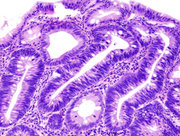Abstract
We describe a rare case of pleomorphic adenoma involving the base of the tongue and adjacent valleculae. We also discuss the incidence, diagnosis, and treatment of these cases.
Introduction
Pleomorphic adenoma is the most common benign tumor arising from the major as well as minor salivary glands. The most common site of occurrence in the minor salivary glands is the palate. To date, very few cases of pleomorphic adenoma involving the base of the tongue and adjacent valleculae have been reported in the literature. We report one such case of pleomorphic adenoma involving the base of the tongue and adjacent valleculae in a 66-year-old woman.
Case report
A 66-year-old woman presented to the ENT outpatient department with complaints of a foreign body sensation and intermittent throat pain of a few weeks' duration. She had no associated history of dysphagia, change in voice, or difficulty in breathing. The patient reported smoking two cigarettes per day for the previous 20 years and was not taking any medications. Examination of the ear, nose, oral cavity, and neck, as well as general physical examination, was unremarkable. Fiberoptic endoscopic examination revealed a smooth mass, 2 cm in diameter, on the posterior third of the tongue in the midline. Rigid endoscopy of the larynx and hypopharynx was normal. A smooth mass, 2 cm in diameter, with an intact overlying mucosa and no extension into surrounding tissues was noted arising from the posterior third of the base of the tongue in the midline. The mass was excised perorally.
Histologic examination revealed a well-encapsulated tumor composed of islands and trabeculae of epithelial cells in a fibromyxoid stroma. No mitotic cells were seen. These features are consistent with a pleomorphic adenoma (figure). The patient did well postoperatively and, to date, is free of recurrence.
Discussion
Tumors of the salivary glands comprise 3% of all neoplasms. (1) The incidence of salivary gland neoplasms in minor salivary glands varies from 9 to 22%. (1-3) The majority of salivary gland neoplasms are benign with pleomorphic adenomas the most common. Approximately 8% of pleomorphic adenomas involve the minor salivary glands. (1) In a review of 1,227 cases of pleomorphic adenoma involving minor salivary glands, Yoshihara and Suzuki found that the majority involved the palate, followed by the lips. (4) Involvement of the base of the tongue was rare. Malignant tumors such as adenoid cystic carcinoma, mucoepidermoid carcinoma, and adenocarcinoma involve the tongue more frequently than their benign counterparts. (4) Chaudhry et al reported that pleomorphic adenomaconstituted nearly 56% of all intraoral minor salivary gland tumors?
Only six cases of pleomorphic adenoma involving the base of the tongue have been reported in the literature (1,2,4,6-8) (table). Most patients with pleomorphic adenoma of the base of the tongue either present with worsening dysphagia or it is detected on routine examination by general practitioners. Patients' ages range from 29 to 87 years with a mean age of 50 years. Male-to-female ratio is 1:1.
Because of its ability to define the soft tissues, magnetic resonance imaging provides useful information on the nature and extent of the lesion, involvement of the lymph nodes, and the status of the surrounding tissues. (2)
The histopathologic appearance of a pleomorphic adenoma is mainly composed of epithelial and myoepithelial elements, which are arranged in a variety of patterns and embedded in mucopolysaccharide stroma. The capsule is usually false, because its formation is caused by the fibrosis of the surrounding salivary parenchyma. (9)
Treatment for pleomorphic adenoma is primarily surgical but depends on various parameters, such as age of the patient and size and site of the tumor. Although these tumors are well encapsulated, resection of the tumor with an adequate margin is essential to avoid recurrence. In a series of 1,342 patients, Spiro reported a recurrence rate of 6% in patients with benign minor salivary gland tumors. (3) Surgical approaches to the base of the tongue vary according to the size and site of the tumor and include transoral, midline transhyoid, and lateral pharyngotomy. (4)
References
(1.) Grewal DS, Pusalkar AG, Phatuk AM Pedunculated pleomorphic adenoma of the tongue base manifesting with dysponea: A case report. J Laryngol Otol 1984;98:425-7.
(2.) Magliulo G, Terranova G, Cristofari P. Pleomorphic adenoma of the tongue base. Ann Otol Rhinol Laryngol 1996; 105:835-7.
(3.) Spiro RH. Salivary neoplasms: Overview of a 35-year experience with 2,807 patients. Head Neck Surg 1986;8:177-84.
(4.) Yoshihara T, Suzuki S. Pleomorphic adenoma of tongue base causing dysphagia and dysphasia. J Laryngol Otol 2000;114:793-5.
(5.) Chaudhry AP, Vickers RA, Gorlin RJ. Intraoral minor salivary gland tumors. Oral Surg Oral Med Oral Pathol 1961; 14:1194-1226.
(6.) Goepfert H, Giraldo AA, Byers RM, Luna MA. Salivary gland tumors of the base of the tongue. Arch Otolaryngol 1976;102: 391-5.
(7.) Deitmer T, Stoll W. [Rare tumors of the base of the tongue and their therapy.] HNO 1985;33:366-9.
(8.) Banerjee S. Benign pleomorphic adenoma of the base of the tongue J R Coil Surg Edinb 1987;32:164-5.
(9.) Heeneman H. Parapharyngeal space tumours. In: Kerr AG, ed. Scott Brown's Otolaryngology. Vol 5, 5th ed. London: Butterworth & Co. Ltd.; 1987:380-91.
From the Department of Otolaryngology and Head and Neck Surgery, Singleton Hospital, Swansea (MI: Berry); the Department of Otolaryngology and Head and Neck Surgery, Fairfield Hospital, Bury (Mr. Tay); and the Department of Pathology, North Manchester General Hospital, Manchester (Dr. Puentes), United Kingdom.
Reprint requests: Sandeep Berry, 65 Marsham Rd., Westhoughton BL5 2GX, UK. Phone: 44-1942-841781 ; fax: 44-1972-285308; e-mail: DOCSN@aol.com
COPYRIGHT 2004 Medquest Communications, LLC
COPYRIGHT 2004 Gale Group



